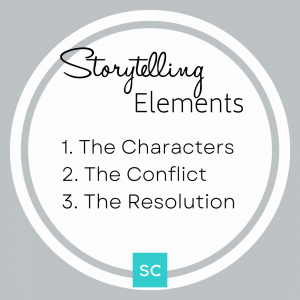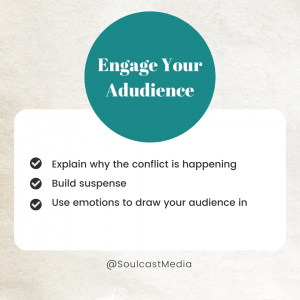3 Storytelling Elements To Boost Communications
Storytelling is a technique you can use to boost your communications. When you implement good storytelling into a presentation, you can connect, and inspire your audience. There are several different ways you can use storytelling in your communications.
- Being interviewed by the media
- Trying to persuade others
- During a presentation
- In a meeting
- Networking events
Just because you are telling a story about your business, or things surrounding your business, doesn’t mean your story has to be boring. If your story is boring, you will lose your audience, and they will become disengaged.
Learning how to become a good storyteller will boost your communications.
Below are 3 storytelling elements to incorporate the next time you tell a story.
1. The Main Characters
The main characters are the people who the story is about. When you have characters in your story, it is easier for the audience to connect with your message. As you describe the main characters, keep the following in mind:
- Who Are They – The audience needs to know your main characters. This is because your audience will relate to the main characters. For example, let’s say you tell a story about how you landed an interview with one of the biggest tech firms. The main characters would include yourself, the person interviewing you, and even the tech company. Making sure the audience knows who these characters are right away will help them envision your story and understand your message.
- Relevant Details – You don’t need to give every detail about your main characters, but you need to include relevant information. For example, when you tell the story about landing the interview, were you desperate for a job? Did the company rarely ever offer interviews to outside candidates? These are relevant details. When you share relevant details, you make the story more exciting and give your audience a well-rounded idea of what is taking place.

Your audience will experience the story through the eyes of the main characters. Be sure your audience knows who they are any relevant details about them.
2. The Conflict
Every story has some conflict or challenge. In other words, what is it the main character must do or overcome? This conflict is what drives the story forward. For example, maybe you are the main character, and you had to find a new job before your next rent payment. Your main character’s challenge is to find a new job.
A good storyteller will lead their audience on a journey using several different tactics:
- Explain The Conflict – A good storyteller will explain the conflict clearly and concisely. This means everyone in the audience understands why the main character is doing what they are doing. For example, if you tell a story about landing a client, the audience needs to know why it was difficult. Maybe the client had never responded to your inquirers. Perhaps no one in your company had ever been able to work with them. The more the audience can understand the why, the more invested they will be.
- Build Suspense – Once your audience understands the conflict, building suspense will keep them engaged. Let’s say you are telling the story about landing a big client. However, landing the client wasn’t easy. Tell your audience the hurdles you had to jump through to get the client. For example, maybe your flight was delayed, and then the airline lost your luggage, so you had to run to the nearest store to buy a suit right off of the rack, and then your Uber was late to pick you up. These are all elements that drive suspense. You want to leave the audience thinking, will the main character make it to their meeting? Will the client say yes?

- Use Emotions – You want your audience to feel something as they listen to your story. More specifically, you want them to feel what your main character is feeling. This is because emotions help your audience connect with your story. For example, let’s say you are trying to persuade your audience to invest in your new company. You can use emotions to show how your company will help change people’s lives for the better. In this way, emotions can help persuade others to take action.
Explaining the conflict, or challenge, with suspense and emotions will captivate your audience and help them stay engaged.
3. The Resolution
Every story needs an ending. If you’ve done your job of taking your audience on a journey, they will want to know if the main character resolves their conflict.
As you wrap up your story, keep the following in mind:
- The Results – The results are what happened. For example, did you land a new client? Did you get the job? You have to tell your audience whether or not the main character resolved the conflict. This doesn’t necessarily mean the results are happy. Maybe you didn’t get the job. That’s okay! The key is making sure the audience knows what happened. Don’t leave them hanging!
- The Reason – Most of the time, you are telling a story for a reason other than just to tell a story. Often, there is another reason for your story. For example, if you are trying to emphasize a point, you may share a story that showcases your point of view. Make sure you are connecting the dots for the audience, so they understand the reason behind the story.
- The Impact – What was the journey’s impact on the main character? In other words, did the main character learn something? Often, the main character’s journey will impact them in the future. For example, let’s say you tell a story about how you failed. This failure most likely impacted how you treated failure in the future. Maybe it showed you how to persevere and never give up. When you can show the story’s impact on the main characters’ lives, the audience can take the lesson with them.
Your audience has been anticipating the ending of your story. Make sure you wrap up the story, so the audience understands how it ended, and any lessons the main character learned.
The art of storytelling is something you can learn. As you practice telling stories, be sure to include these 3 elements, so your audience is engaged and understands the intent of your message.
___
Whenever you’re ready, there are 3 ways we can help you:
- Discover your communications style so you know where to start. Over 4,000 people have found theirs here.
- Attend our monthly communication workshop to build communications confidence (new topics: public speaking, advocating for yourself, building credibility, etc) here.
- Get your brand in front of 43k+ people by sponsoring our newsletter or Soulcast Media | LIVE LinkedIn events [contact: hello@soulcastmedia.com]











